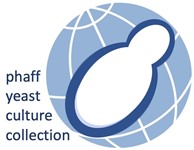Roughly 100 unpublished species have been discovered through sequencing of the D1/D2 region of the large (26S) ribosomal subunit. This database can be queried by Phaff collection personnel to find matches to your unpublished species.
In addition, the Phaff collection strain physiology database uses the powerful collection management program BioloMICS, and contains over 50 years of primarily unpublished strain characterization data, originally used for species identification and classification. This information is proving to be extremely useful for selection of strains with specific characteristics for use in academic or commercial research. For example, strains that assimilate a particular carbon source and grow at a certain temperature can be selected. Phaff collection personnel can search this database for strains on behalf of users of the collection.
Original data sheets have been located for over 4500 yeast strains, but approximately 2000 strains were either not assayed or the data has not been located. Please note that the types of assays performed changed over the years, so not all tests were performed on all strains. Additional screening of previously untested strains may identify additional candidates. Phaff collection personnel perform contract research to screen strains in the collection for particular properties.
The following lists describe the types of data in the newly expanded database. Most of this data is from the original Phaff lab data sheets. The list labeled "CBS data" contains information provided by the Centraalbureau voor Schimmelcultures, Utrecht, Netherlands, which they have gathered on approximately 700 strains that are present in both the Phaff collection and the CBS collection.
Categories
General description:
Phaff collection ID number
ID number in other collections including ATCC, CBS and USDA-ARS (NRRL)
Genus, species
Haploid mating type
Colony morphology
DNA G+C content
Source of isolation: Location
Source of isolation: Habitat
Taxonomic authority
Literature references for specific strain
Diazonium Blue B
Pellicle
Pulchrine pigment
Whether this is the type strain
Carbon sources assimilated: Phaff data
Acetate
Acetone
N-Acetyl-D-glucosamine
Adonitol
D-Arabinose
L-Arabinose
D-Arabitol
L-Arabinitol
Cellobiose
Citrate
Dulcitol
i-Erythritol
Ethanol
Ethyl acetate
Galactitol
Galactose
D-Glucitol
D-Gluconate
Glucono-delta-lactone
Glucosamine
Glucose
D-Glucuronate
Glycerol
Hexadecane
myo-Inositol
Inulin Quinic acid
2-Keto-D- gluconate
5-Keto-D- gluconate
D,L-Lactate
Lactose
L-Malate
Maltose
D-Mannitol
Melezitose
Melibiose
Methanol
Alpha-Methyl-D- glucoside
Alpha-Methyl-D-glucoside
Oxalic acid
1-Propanol
2-Propanol
Pyruvate
Raffinose
L-Rhamnose
D-Ribose
Saccharate
Salicin
D-Sorbitol
L-Sorbose
Soluble starch
Succinate
Sucrose
Trehalose
D-Xylose
Xylitol
Additional carbon sources assimilated: CBS data
Arbutin
D-Galacturonate
Propane-1,2-diol
Propane-2,3-diol
D-Glucarate
D-Galactonate
Palatinose
Levulinate
L-Tartaric acid
D-Tartaric acid
Meso-Tartaric acid
Galactaric acid
Uric acid
Gentobiose
Ethylene glycol
Carbon sources fermented
Cellobiose
Galactose
Glucose
Inulin
Lactose
Maltose
Melezitose
Melibiose
Raffinose
Soluble starch
L-Sorbose
Sucrose
Trehalose
Nitrogen sources assimilated
Ammonium sulfate
Cadaverine
Creatine
Creatinine
Ethylamine
Glucosamine
Imidazole
L-Lysine
Potassium nitrate
Potassium nitrite
D-Proline
Putrescine
D-Tryptophan
Growth temperatures
0ºC
4ºC
6ºC
9ºC
12ºC
20ºC
24ºC
25ºC
27ºC
30ºC
33ºC
35ºC
36ºC
37ºC
39ºC
40ºC
42ºC
45ºC
50ºC
Growth in the presence of growth inhibitors and stresses
4% NaCl
5% NaCl
7.5% NaCl
10% NaCl
12.5% NaCl
50% Glucose
60% Glucose
Vitamin-free medium
Amino acid-free medium
1 µg/ml Cycloheximide
10 µg/ml Cycloheximide
100 µg/ml Cycloheximide
1000 µg/ml Cycloheximide
Agria cactus extract, 1%
Cina cactus extract
Organpipe cactus extract, 2%
pH = 3
pH = 9.5
Fluconazole
Digitonin, 25 ppm
Secretion or production of products
Acid production
Protease activity: casein hydrolysis
Protease activity: gelatin hydrolysis
Pectin hydrolysis
Lipase activity: suet hydrolysis
Lipase activity: Tween 40 hydrolysis
Urease
Starch synthesis
Killer of Y55
